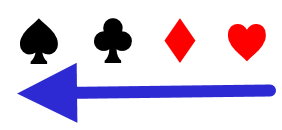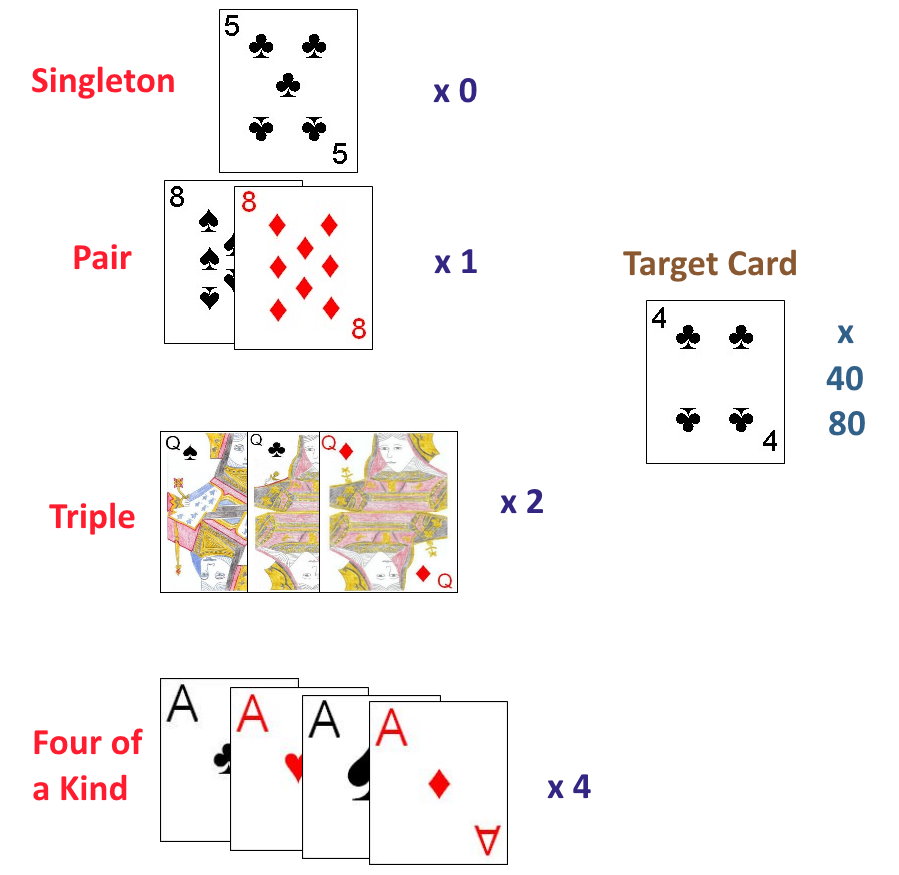 Apples is a unique trick taking card game which was invented in the Summer of 2009 by two members of the U.S. team, during the 41st International Chemistry Olympiad which occurred in England that year. Apples is a very unique trick taking game, having elements common with several other popular games of the trick taking family
as well as some unique features of it's own.
Apples is a unique trick taking card game which was invented in the Summer of 2009 by two members of the U.S. team, during the 41st International Chemistry Olympiad which occurred in England that year. Apples is a very unique trick taking game, having elements common with several other popular games of the trick taking family
as well as some unique features of it's own.
The game uses one standard 52 card deck. The ranking of the cards in this deck are as follows (from high to low); Ace, King, Queen, Jack, 10, 9, 8, 7, 6, 5, 4, 3, 2. It is designed to be played by four players, each playing independently.
Determination of seating positions and the first dealer can be performed in a variety of ways, with dealing for high cards a common method. In that method, each player draws one card from a shuffled, face down deck. The players would seat themselves at the table in the order of cards drawn, from highest to lowest. The player drawing the highest card of all is set as the first dealer.
Once the first dealer has been determined and the players are seated, the dealer should then thoroughly shuffle the deck and offer it to the player at his right to cut. After the cut, the dealer then begins dealing the cards in a clockwise direction around the table, face down and one card at a time, starting with the player at his immediate left. He continues dealing until the entire deck has been dealt. After the deal has been completed, bidding begins with the player to the immediate left of the dealer and continues in a clockwise direction around the table.
Each player, in rotation names a number and a suit (such as "Two, Spades") or may pass. Each subsequent player may either name a higher bid than any yet stated or pass. If all four players pass, the cards are thrown in and a new hand is dealt by the next dealer in turn.
 For purposes of this ranking the suits are
also ranked, using the following order from highest to lowest: Spades, Clubs, Diamonds, Hearts. Thus, for a bid to be considered higher than another such bid, it must either name a higher number or be of the same number as the current highest bid but in a higher ranked suit. A player may never make a bid higher than the number of cards they have in the suit called as part of that bid. The bidding continues in rotation until a high bid is followed by three consecutive passes. This bid is then considered the winning bid for the hand.
For purposes of this ranking the suits are
also ranked, using the following order from highest to lowest: Spades, Clubs, Diamonds, Hearts. Thus, for a bid to be considered higher than another such bid, it must either name a higher number or be of the same number as the current highest bid but in a higher ranked suit. A player may never make a bid higher than the number of cards they have in the suit called as part of that bid. The bidding continues in rotation until a high bid is followed by three consecutive passes. This bid is then considered the winning bid for the hand.
Once the winning bid is determined, the suit named is set as the trump suit for the hand. The player making that bid must place a number of cards of that trump suit face-up to the center of the table in a "bidding pile". Each other player must also place the same number of cards into that bidding pile, but these can be any cards of that player's choice from his hand. After all players have placed the requisite cards into the pile, this pile is shuffled and the cards from the bidding pile re-dealt to the four players.
After the bidding, each player takes one card of choice from his hand and places it face-down to his side. This is called the target card for that player.
The player who won the bidding then has the privilege of playing the first card to the first trick. When leading to a trick, a player has the option to play any card remaining in his hand to start the trick. Each other player, in a clockwise rotation from that player than plays one card to the trick. The player must play a card of the same suit as led to the trick if he has one. If he does not have such a card, he may play any card from his hand, including a card from the trump suit. The winner of each trick leads the first card to the next trick.
| Trivia: The game takes it's name from a common idiom in the English language regarding Apples and Pears, with the Pears coming from the fact that players' attempt to form "Pairs" to earn points during the game. |
After all the cards have been played in tricks, the players examine the cards found in the winnings pile. Players should first add the target card to this winnings pile, but should note the specific rank of this card. The player then removes from this pile (which includes the target card), any cards that are not part of a pair, triplet or quadruplet. These single cards (singletons) removed are set aside and have no score. Each card rank in the game has a special point value as per the following chart:
| Card | Point Value |
|---|---|
| Ace | 15 |
| 10, Jack, Queen, King | 10 |
| 6, 7, 8, 9 | 5 |
| 2, 3, 4, 5 | -15 |
 The values of these cards is modified by if that card is part of a pair, triple or four-of-a-kind. For a pair, the cards retain their stated value. For a triple, the total value of all cards in the triple is doubled and if part of a four-of-a-kind, the total value of all cards in that four-of-a-kind
are quadrupled. One exception to this scoring is if the combination includes the target card. If a pair includes the target card as part of that pair, the total is unchanged. However, if the target card is part of a triple, the value of that triple is set at 40 points and if the target card is part of a four-of-a-kind the value of that four-of-a-kind is automatically set at 80 points (regardless of the actual value of the denomination of the cards in that combination). Negative scores are possible and common during the early parts of the game.
The values of these cards is modified by if that card is part of a pair, triple or four-of-a-kind. For a pair, the cards retain their stated value. For a triple, the total value of all cards in the triple is doubled and if part of a four-of-a-kind, the total value of all cards in that four-of-a-kind
are quadrupled. One exception to this scoring is if the combination includes the target card. If a pair includes the target card as part of that pair, the total is unchanged. However, if the target card is part of a triple, the value of that triple is set at 40 points and if the target card is part of a four-of-a-kind the value of that four-of-a-kind is automatically set at 80 points (regardless of the actual value of the denomination of the cards in that combination). Negative scores are possible and common during the early parts of the game.
The game continues until one or more players manages to score 250 or more accumulated points over the course of multiple hands. If multiple players reach or exceed this total, the player with the highest total is declared the winner.